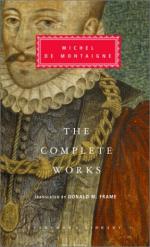|
This section contains 396 words (approx. 1 page at 400 words per page) |

|
Complete Works: Essays, Travel Journal, Letters Summary & Study Guide Description
Complete Works: Essays, Travel Journal, Letters Summary & Study Guide includes comprehensive information and analysis to help you understand the book. This study guide contains the following sections:
This detailed literature summary also contains Topics for Discussion and a Free Quiz on Complete Works: Essays, Travel Journal, Letters by Michel de Montaigne.
This is a translation of the works of one of the world's most well respected Frenchman. He lived during the waning era of feudalism on the European Continent. He has compiled a number of essays ranging in length from that of an entire book to far shorter ones, more along the lines of a brief essay. The shorter ones heavily outnumber the longer ones. There is one work, the Apology of Raymond Sebond, which is well over a hundred pages. The author espouses his views and through doing so himself. His purpose is to express himself: while simple, the idea is fabulous. He wants to share himself with readers. His main target audience was people who would miss him after his death. As such, he felt himself able to write his opinions with minimal censorship.
The editors have laboriously translated this sizable manuscript. Through this act of love, vast descriptions of ideas have been ordered by both the author and the editors. There is a general chronological order to the essays. The arrangement of the topics does not appear on the surface to have any deeper connection. The subjects vary from the education of children to philosophy and military tactics. There are innumerable anecdotes, some of which come directly from the author's life whereas others show Montaigne's own educational background. He has apparently read or listened to lectures about many classical figures. The means of his learning about these has not been cited. He grew up in a privileged household: amongst other things, this meant gentleness and education. There may well have been books and educated instructors. [Empowering women to tutor their own children was used by some as a primary argument to educate girls and women. For others, this was really the father's duty.]
One of the most prominent works within the body is a defense of Christianity called an Apology to Raymond Sebond. This essay is so extensive that there are two summary chapters devoted to this one essay. There is sizable Travel Journal and then a set of Letters that come after the Essays. The entire work is delightfully interesting to readers for numerous reasons. It is a treasure for the rather informal education. In a pinch it could be used as a textbook but it is very clear that the author does not have this usage in mind.
Read more from the Study Guide
|
This section contains 396 words (approx. 1 page at 400 words per page) |

|



